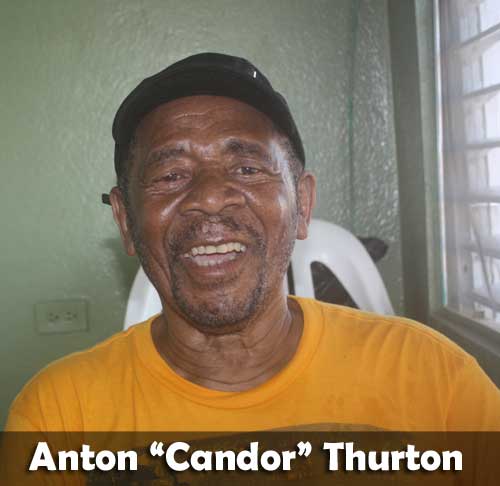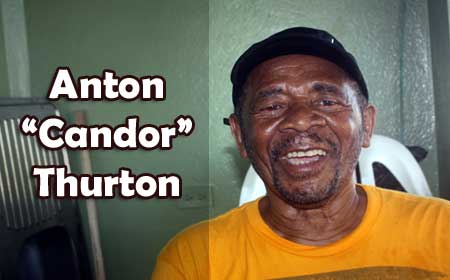BELIZE CITY, Sun. Sept. 17, 2017–(My former Diamond-A teammate Solomon Usher informed me of his presence in the old capital, and I met Cador at his family home, corner Collet Canal and Cemetery Road, on Wednesday evening, September 13. Unfortunately, much of the recording of our football discussion was lost due to noise interference from heavy traffic in the neighborhood. But I did manage to capture a few gems. Cador, who now resides in Los Angeles, is on a one-month visit back to the Jewel.)
What makes a football “star”? What qualifies one, from among the legions of actors on the football stage in any generation, to be called a “football star”? Is it, to be accomplished in all aspects of performance on the field relative to one’s particular position or assignment? To be well known by name or nickname, and highly respected across the spectrum of football fans? To be recognized and deemed qualified by the decision makers of the sport to be a member of the “All Belize” team (as the Belize City selection was known in those days)? To be one sought after by top teams to join their ranks, and then jealously held on to, and reluctant to see one lured away by another top team in the competition? Or perhaps all of the above? And then some.
There are some very big names of footballers in times past, which have become legends of the game, for one reason or another; mostly because they were regarded among the very best in their day; but often because of their personal flamboyance, or being the architect of some spectacular feat or achievement that ignites the everlasting imagination of die-hard fans of the sport. And there are debates sometimes about their relative rank in skill, ingenuity, tenacity, competitive spirit, guile, leadership qualities, goal scoring acumen, and ability to rise to the occasion in “big games.”
As a very young football fan, growing up in the 1960s in Belize City, the name “Cador” was stuck in my mind, not for anything that I can recall him doing in a particular game; but I heard grown-ups call his name enough times at games, for me to know who was “Cador” on the football field. And I recognized him enough to register in my mind the curious phenomenon when I witnessed the erstwhile footballer sitting behind the “trap set” not long after a football game, and playing the drums for the Glenn Bood (and the Telegrams) Combo. At the time I thought Cador was just giving it a try; I didn’t realize he also performed as a regular with the band, often playing drums on a Saturday night, and then playing football on the Barracks the following day. The fact that Cador could not only “ketch team,” but in fact was a regular starter on three of the most renowned teams of the 1960s – Landivar, Brodies and Independence, says enough about the quality of the player, Anton “Cador” Thurton; and why I now feel amply justified in according the description, Belizean football star, after the name, “Cador.”

Amandala (A): You said you started playing with Landivar?
Cador (C): Yes, Landivar, in 1959.
A: How old were you then?
C: I was 17 years of age. That’s when I first played with the National Team (All Belize) too, at 17.
A: That’s when you were on Landivar, with Mr. Hoy and Angus (Vernon)?
C: Boy, that was my idol. Angus! That was my idol, boy.
A: Mr. Ball!
C: Yaa, Mr. Ball! That’s what we called him.
When I was growing up, right? I saw him play on the team … first time you will hear this … a team named Excelsior. Angus had just come out of college (high school), and he played with Excelsior; and he was good. I think, growing up, going to school, and I watched him play, he used to be my idol. I said, “I want to play with this guy baad.”
A: What school were you going to at that time?
C: Ebenezer.
A: A lot of guys went to Ebenezer, who went on to do a lot of things later on in football… Chico, Pine, etc.
C: Oh, yeah! Those were the guys. I always tell the guys, right?
A: Who was coaching you all (at Ebenezer) at that time?
C: We didn’t have a coach… But we stay successful because, when you go to that school, you don’t like to lose.
A: Eben! Eben!!
C: That’s the name; Eben!
A: I remember big games with “Mary’s” and “Eben” at the old Edwards Park (now Rogers Stadium).
C: Bwai!… you remember those days at Edwards Park!?
A: Yes, man. I was small, but I saw some of those games…
C: Boy … you’re taking me way back … (laughs), when those guys were playing some games!
A: Yaa. I was a little boy …
C: Yea, because when I used to know you, Charlie … I remember, I used to meet you right at the corner of Barrack Road and Freetown, right by the bell, you and “Blacker” (Alger Bradley), who died. You used to take the shoes from me, and Blacker got the bag.
A: Ahaahn?
C: And when we get to the gate, the man would start to give you guys a hard time … And I would say, “No, these are the guys of tomorrow … When I finish and can’t play no more, these guys will take over and be the ones to play …. So they want to see somebody good to play and see a good game.”
A: Yaa, Blacker was alright. (Although I don’t remember the incident, as Blacker was a few years younger than me, and not a colleague.)
C: Yaa … but coming back … in those days of playing the game … that was 1959 … and Angus … at this time there was a very good team named Dunlop!
A: Yaa!
C: Like I said, Dunlop! You heard about that team, right?
A: Oh, yes, man! What!? Dunlop! That was one of the most …
C: Now, Pino, and Ellis (Chico), and all those guys they got mad with me, because they wanted me to play for this team (Dunlop) … but I told them …
“Those guys are a good team … you guys are alright … but I will play with Mr. Hoy, due to Angus Vernon, right?”
They said, “Yaa, Angus alright, but … come and play with us on the right side.”
I said, “No; I will play over here.”
So I went with Angus and played with Landivar.
When that season began, 1959 … the first game was to be played at Edwards Park, then … and it was Landivar vs Dunlop … Bwai! I tell you, dehn people dehn wahn bruk down di fence … When I tell you di stadium jam, i jam, bredda!!
And you know weh Pino seh to me? He said, “So yo mean yo gweyn play fi Landivar.” He said, “Well, yo wahn get it!!”
A: Dunlop had just won the previous season (1958-59), when they had gone up from junior to senior, right? 58-59?
C: Yes. And 1959, dehn bwai come back with di same team. And I am with Landivar, right?
And when da game start … you know, that’s why I always say … we didn’t have no T.V. and all those things in those days fi see dehn kinda play, yo know? …
A: But dehn game mi big!!
C: What?!! Bwai, look ya … da neva no joke!!
(See Part 2 on page 53. Cador re-lives the dramatic season-opening confrontation between the young defending champions, Dunlop, and the team he then played with, Landivar.)

